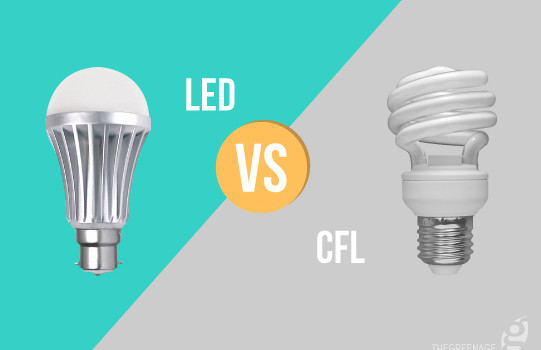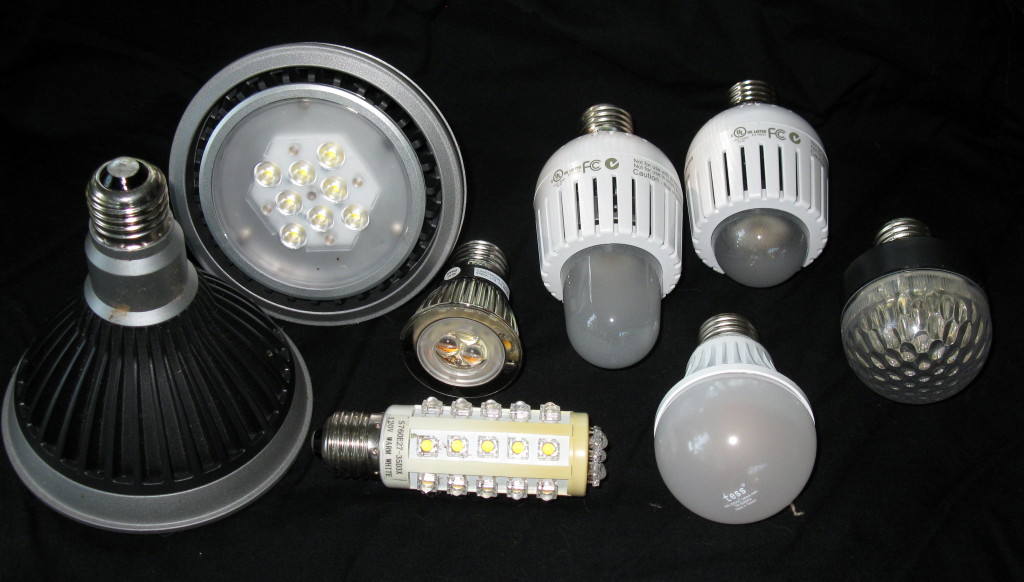
Compact fluorescent lights have been around for many years, and their energy saving properties have been touted by the Government, energy companies and green organisations alike, but how do they compare to the new kids on the block – LED lights?
LED lighting has been around for only a few years and it is considerably more expensive, so which bulb should you have in your home?
Its time for LED vs. CFL… let battle commence!
Cost
CFL energy saving bulbs are pretty cheap. They can cost as little as £1 each, so it is hard to compete with them on price alone. LED’s vary wildly, but you won’t find a quality bulb for under £5.
Winner: CFL
Energy Usage
CFL’s are much more efficient than incandescent, sometimes up to 7 times so. That can all add up to some pretty big energy savings when you think about replacing all the bulbs in a property. LEDs are also very efficient; in fact in almost all cases they outperform their CFL counterparts.
A 40w Incandescent bulb is comparable to a 12w CFL bulb, which is equivalent to a 6w LED – so the LEDs get a small victory here.
Winner: LED
 Quality of Light
Quality of Light
This is quite a complicated one. There are three things that determine the quality of light produced from a source. The Lumens, which is the brightness, the colour temperature, which determines the colour of the light (e.g. warm white found in homes or cool white found in offices) and the colour rendering which determines the actual quality of the light.
Colour rendering is a measure of the ability of a light source to reproduce the colours of various objects faithfully in comparison with a natural light source. This is measured on the colour rendering index (CRI) which is a scale of 0 – 100, with natural light being the best and therefore 100.
While CFL bulbs may achieve a maximum CRI of 85, LEDs can hit 90+ so while colour temperature and lumens is comparable between the bulbs, when it comes to CRI there is only one winner!
Winner: LED
Dimmability
When it comes to dimmability, you can get dimmable CFL and LED bulbs, although for both you will need the dimmable variety and a special dimmer switch that has the correct transformer. Dimmable bulbs cost a little more for both CFL and LED.
A Draw!
Warm-up Period
CFL’s are notorious for having a long ‘warm-up’ time. It can take minutes before they reach full brightness, which is really annoying if you are only in the room for a minute. LEDs don’t have this problem – they are either ‘on’ or ‘off’ and provide instant light from the moment they are switched on.
Winner: LED
Lifespan
CFL bulbs tend to give a rated lifespan of around 10,000 hours. LEDS claim up to 50,000 hours, so it is clear that whilst being more expensive, the LED will be around for a lot longer. This of course depends on the quality of the bulb – if you buy a cheap, substandard LED, the lifespan will be considerably less. Only go for bulbs with a lengthy guarantee.
Winner: LED
Environmental Credentials
CFL bulbs use a small amount of mercury – this is a really dangerous element that you don’t want to come into contact with. Not only is it bad for us – it is a neurotoxin and if it gets into the natural environment it can be bad news for wildlife. CFL’s must be recycled in order to avoid this from happening and you need to be careful if you happen to break one! LEDs don’t have this problem, so another win for the LED here!
Winner: LED
Aesthetics
Beauty is in the eye of the beholder, so we will call this one a draw too, although when I was in the shops the other day I did come across this little beauty!
A Draw!
CFL 1 : LED 5 ( + 2 Draws!)
We think the winner is fairly clear. Whilst the CFL is certainly a better option than a traditional incandescent, the LED is far better still. While both are guaranteed to save you money on your electricity bills, when replacing incandescent counterparts, LEDs offer that extra bit of quality, durability and performance, which makes them TheGreenAge’s number one choice for bulbs.
Think we missed something? Do you have a different opinion?
Comment below to get your voice heard…













LEDs are energy-efficient, eco-friendly & longest lasting for sure but do they faithfully renders the colors? What is the required CRI rating for indoor photography? Should I look for higher lumen ratings as well? What is the correlation between Lumens-Wattage-CRI? I found this page ( https://www.ecofinsolution.com.au/blog/why-should-you-upgrade-cfls-to-leds/) explaining the relation between Lumens and Wattages. Do you think there is any association between Lumens and CRI?
Hi Richard,
I see plenty of office and retail refurbishments and they rarely have a full lighting design carried out. If you are trying to hit a certain performance level, or you need your EPC to hit the higher levels, then a full lighting design would certainly be preferable, but I do not believe it would be a legal requirement in your case. Please ensure that you get a proper consultation on the best lighting setup however. You want to ensure the occupants have sufficient lighting levels and are satisfied tenants.
Best,
Alan